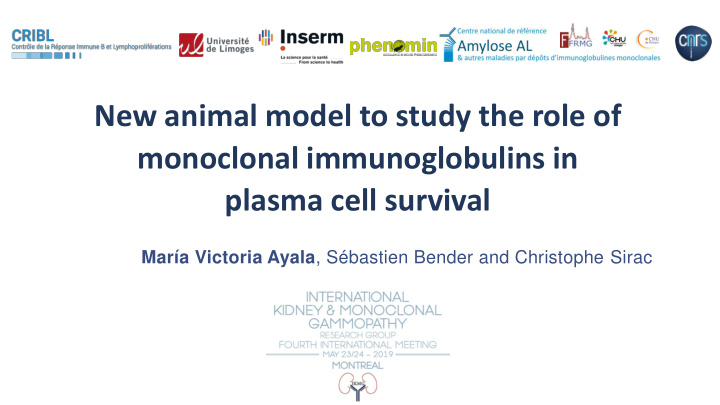



New animal model to study the role of monoclonal immunoglobulins in plasma cell survival María Victoria Ayala , Sébastien Bender and Christophe Sirac
Disclosure of f Conflict of f In Interest ❑ I do not have a relationship with a for-profit and/or a not-for-profit organization to disclose X I have a relationship with a for-profit and/or a not-for-profit organization to disclose Name of for-profit or not-for-profit Description of relationship(s) Nature of relationship(s) organization(s) Unversité de Limoges Employer Any direct financial payments including receipt of honoraria Membership on advisory boards or speakers’ bureaus Not-for-profit: Research funds - Fondation Française pour la recherche sur Funded grants or clinical trials le Myélome et les gammapathies - Ligue Contre le Cancer (France) Patents on a drug, product or device All other investments or relationships that could be seen by a reasonable, well- informed participant as having the potential to influence the content of the educational activity
In Introduction • Plasma cell development is closely linked to their capacity to cope with Endoplasmic Reticulum (ER) stress during massive production of Immunoglobulins • Abnormal Immunoglobulins can themselves be stressors and could explain the difference in Proteasome Inhibitors sensitivity We want to explore the direct effect of different pathogenic immunoglobulins on Plasma Cell proliferation/stress • No mouse model available to study the toxicity induced by different immunoglobulins in differentiated Plasma Cells Use of B- Emerging Plasma cells specific Selection derive from B-cells that promoters overcome the stress of bias (CD19, toxic immunoglobulins CD21)
First model of plasma cell-specific induction Active Knock In (IgJ locus) CreERT2 Inactive Recombinase CreERT2 T Recombinase CreERT2 3 ’ Arm IgJ PA 5 ’ Arm IgJ IgJ Promoter CreERT2 ERT2 Cre ERT2 Cre Only active in CD138+ cells /secreting cells STOP Gene X CreERT2 LoxP LoxP T STOP Gene X Tamoxifen LoxP LoxP (ERT2 agonist) Oncogenes (c-MyC, Bcl2) STOP Gene X LoxP LoxP Pathogenic Ig
First model of plasma cell-specific induction Plasma Cell T T ERT2 CreERT2 Cre Tamoxifen Tomato STOP Tomato (ERT2 agonist) LoxP Plasma Cell LoxP LoxP + IgJ-CreERT2 x Tomato Mouse Tomato STOP fluorescent Plasma cells protein B cells
Monoclonal Im Immunoglobulin Mouse Model CH1- + IgJ-CreERT2 V CH2 CH3 Mouse Selection bias? x CreERT2 + LoxP CH1+ Truncated CH2 CH3 V CH1 Mouse Heavy Chain LoxP LoxP (CH1-) Heavy Chain Deposition Disease ✓ Check the effect of truncated HC on PC while (HCDD) mouse inducing deposits formation in kidney
Monoclonal immunoglobulin effect on PC PC Total Spleen Cells- LPS stimulation D4 IgJ-CreERT2 x LoxP CH1+ Mouse IgJ-CreERT2 x Tomato Mouse HCDD (CH1-) Mouse Treated Treated (CH1-) Non Treated (CH1+) PC PC PC CD138 Less Plasma PC B cells Cells B cells B cells B cells B220 Death is caused by the modification of the When PC develops with the truncated The truncated Heavy Chain immunoglobulin and not the production of a Heavy Chain produced from early stages generated causes a difference in “novel” protein in PC: Tomato induced in there is no death : PC “ selected ” during B stress that kills plasma cells differentiated PCs does not provoke death cell development to tolerate stress levels
Plasma Cell Death Sorted PCs and B cells - LPS stimulation D3 B cells Plasma Cells Non Treated Treated 12H Treated 12H Non Treated B220 CD138 4-fold more dead cells Fixable Viability Stain 780 (FVS780) Fixable Viability Stain 780 (FVS780) B cells Plasma Cells Non Treated Treated Non Treated Treated 12H OH-Tamoxifen CH1+ Treatment CH1-
Perspectives • In vivo assays to validate ex vivo findings • Analyse the precise mechanism involved in PC cell death using the IgJ-CreERT2 x LoxP CH1+ Mouse as well as others (Light Chain Deposition Disease, Fanconi Syndrome, etc) • Study of PC that become resistant: molecular mechanisms and proteasome inhibitors sensitivity
Thanks for your attention!
Recommend
More recommend